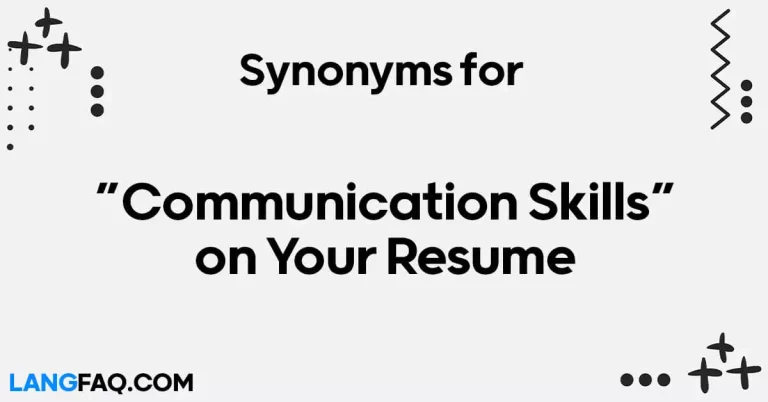In a world that often moves at breakneck speed, finding alternative expressions to convey the simple notion of “Take Your Time” can add depth and versatility to our communication. This article will explore various phrases, idioms, and expressions that serve as effective substitutes for the commonly used phrase. Let’s delve into the rich tapestry of language and discover new ways to express patience and thoughtfulness.
12 Other Ways to Say “Take Your Time”
Here are 12 alternative ways to express “Take Your Time”:
- Proceed at Your Own Pace
- Relax and Reflect
- Give It Due Thought
- No Rush, No Hurry
- Linger a While
- Cherish the Moment
- Exercise Patience
- Enjoy the Journey
- Take a Breather
- Savor the Experience
- Move Deliberately
- Appreciate the Process
Here’s a table with meanings and examples for the 12 alternative ways to say “Take Your Time”:
| Expression | Meaning | Example |
|---|---|---|
| Proceed at Your Own Pace | Move forward according to your comfort and preferred speed | “Feel free to proceed at your own pace; there’s no rush.” |
| Relax and Reflect | Unwind and contemplate before taking any action | “Take a moment to relax and reflect before making a decision.” |
| Give It Due Thought | Ponder the matter thoroughly before responding | “I encourage you to give it due thought before committing.” |
| No Rush, No Hurry | Take your time without any pressure | “There’s no rush, no hurry; complete the task at your own pace.” |
| Linger a While | Extend the moment, savoring the experience | “Feel free to linger a while and enjoy the beauty around you.” |
| Cherish the Moment | Value and appreciate the present time | “Cherish the moment; it’s a unique opportunity.” |
| Exercise Patience | Cultivate the virtue of waiting with grace | “In challenging situations, remember to exercise patience.” |
| Enjoy the Journey | Find joy in the process, not just the destination | “Life is a journey; enjoy the journey, take your time.” |
| Take a Breather | Pause for a moment of respite | “If things get overwhelming, take a breather and regroup.” |
| Savor the Experience | Appreciate and relish the unfolding experience | “Savor the experience, every moment holds something special.” |
| Move Deliberately | Proceed with careful consideration and intention | “In important matters, it’s crucial to move deliberately.” |
| Appreciate the Process | Value the steps taken and the learning in the process | “Success lies not just in the outcome but in appreciating the process.” |
In our daily interactions, the way we convey the idea of “Take Your Time” can greatly impact the tone and understanding of the message. These alternative expressions offer a diverse range of options, allowing individuals to choose phrases that align with the context and desired sentiment. Whether it’s encouraging someone to relax, reflect, or cherish the moment, these alternatives enrich our communication and promote a more thoughtful approach to time management.
Is It Correct to Say “Take Your Time”?
Absolutely, “Take Your Time” is a commonly used and perfectly correct expression. This phrase is a polite way of advising someone to proceed at their own pace without feeling rushed or pressured. It is often used in various contexts, both in professional and personal settings.
Formal Context:
- In a professional environment, a supervisor might say, “You have a complex task ahead; take your time to ensure accuracy.”
Informal Context:
- In a casual conversation, a friend might say, “I know you’re making an important decision. Take your time; there’s no rush.”
Email Example: Subject: Project Update Dear Team, As we approach the final stages of the project, I want to emphasize the importance of quality over speed. Take your time to review and ensure all aspects meet our standards.
Dictionary Insight: The phrase “Take Your Time” is idiomatic and means to proceed at a comfortable or unhurried pace, without feeling pressured.
Pros:
- Encourages a thorough and thoughtful approach.
- Demonstrates respect for the individual’s process.
Cons:
- In some urgent situations, alternative expressions emphasizing urgency might be more suitable.
Tips:
- Use it in situations where quality is more crucial than speed.
- Be mindful of the overall context to ensure appropriateness.
Professional Mail Example With “Take Your Time”
Subject: Project Review – Please Take Your Time
Dear [Recipient’s Name],
I trust this email finds you well. As we enter the final phase of the project, your expertise and attention to detail have been invaluable. I appreciate the dedication you’ve shown to ensuring the success of our collective efforts.
Given the significance of the upcoming project review, I want to emphasize the importance of a thorough examination. Take your time to meticulously go through the deliverables, ensuring that each aspect aligns seamlessly with our project goals and standards.
Your commitment to excellence has been evident throughout this project, and I have full confidence in your ability to provide insightful feedback. If you come across any areas that require further clarification or discussion, please do not hesitate to reach out.
The deadline for your review is [insert date], allowing ample time for a comprehensive evaluation. Your insights are crucial in shaping the final outcome, and your dedication to quality is truly commendable.
I appreciate your continued hard work and commitment to our shared objectives. Thank you for your attention to detail and the valuable contributions you bring to the team.
Best Regards,
[Your Full Name] [Your Position] [Your Company]
Proceed at Your Own Pace
In the fast-paced world we live in, the phrase “Proceed at Your Own Pace” serves as a gentle reminder that everyone has their unique rhythm. This expression is versatile and can be applied in both formal and informal settings, making it a valuable addition to our communication toolkit.
When to Use:
- Professional Context: In a workplace scenario, when delegating tasks, it’s essential to acknowledge the diverse working speeds of team members. Encouraging them to proceed at their own pace fosters a supportive work environment.
- Casual Conversation: In personal relationships, this phrase can be used to reassure someone who might be feeling overwhelmed or pressured. It communicates understanding and respect for their individual speed.
Example: Dialogue in a Professional Setting: Manager: “We have a tight deadline, but I want each of you to proceed at your own pace. Quality is as important as speed in this project.”
Email Sample:
Subject: Project Update
Dear Team, As we navigate through the project timeline, I want to emphasize the importance of proceeding at your own pace. Quality remains our top priority, and your individual working speeds contribute to the overall success of the project.
Variations:
- Colleague Relationship: “Feel free to proceed at a comfortable speed; we value the quality of your contributions.”
- Mentor-Mentee Relationship: “In your learning journey, proceed at your own pace, ensuring a thorough understanding of each concept.”
Dictionary Insight: According to Cambridge Dictionary, the phrase “Proceed at Your Own Pace” means to do something at a speed that is comfortable for you, without hurrying.
Pros:
- Encourages individuality and autonomy.
- Fosters a positive and inclusive environment.
Cons:
- May require clear communication to ensure alignment with project timelines.
Tips:
- Regularly check in with team members to understand their progress.
- Provide additional support if someone feels pressured to speed up.
Relax and Reflect
In moments of heightened stress or decision-making, the phrase “Relax and Reflect” serves as an oasis of calm, promoting thoughtful consideration before taking any action. This expression is particularly effective in conveying the importance of taking a step back for a clearer perspective.
When to Use:
- Formal Setting: In professional discussions or meetings, using this phrase signals the need for a collective pause to think strategically before making significant decisions.
- Informal Setting: In personal relationships, suggesting to “Relax and Reflect” can defuse tense situations and encourage open communication.
Example: Dialogue in a Formal Meeting: Team Lead: “Before we finalize the budget, let’s all take a moment to relax and reflect on the long-term implications of our decisions.”
Text Message Sample:
Friend: “Hey,
I know things have been tough lately. How about we meet up this weekend? Relax and reflect on everything. It might help.”
Variations:
- Colleague Relationship: “In times of high pressure, it’s crucial to relax and reflect on our strategies for optimal results.”
- Mentor-Mentee Relationship: “As you navigate your career path, remember to relax and reflect on your goals and achievements.”
Dictionary Insight: Cambridge Dictionary defines “Relax and Reflect” as taking time to rest and think carefully about something.
Pros:
- Encourages mindfulness and strategic thinking.
- Facilitates open communication by reducing stress.
Cons:
- Requires a team culture that values reflection.
Tips:
- Incorporate brief relaxation exercises in formal settings.
- Create a comfortable space for reflection, whether physical or virtual.
Give It Due Thought
The expression “Give It Due Thought” elevates the act of thinking into a deliberate and considerate process. It emphasizes the importance of thorough consideration before responding, making it ideal for both professional and personal situations.
When to Use:
- Professional Correspondence: In emails or written communication, using this phrase signals that the matter at hand requires careful consideration.
- Personal Advising: When offering guidance or advice, suggesting to “Give It Due Thought” underscores the significance of making well-informed decisions.
Example:
Email Sample:
Subject: Important Decision Ahead
Dear [Recipient],
I trust this email finds you well. As we approach a crucial decision point, I encourage you to give it due thought. Your insights are valued, and a thoughtful response will contribute significantly to the team’s success.
Dialogue in a Personal Setting: Friend: “I’m thinking of changing careers, and it’s a big decision. Can you give me some advice?” You: “Absolutely, take your time and give it due thought. Consider your passion, skills, and long-term goals.”
Variations:
- Colleague Relationship: “In our team discussions, it’s essential for everyone to give it due thought before proposing solutions.”
- Mentor-Mentee Relationship: “As you navigate your career, remember to give due thought to opportunities that come your way.”
Dictionary Insight: According to Cambridge Dictionary, “Give It Due Thought” means to think carefully about something before making a decision.
Pros:
- Promotes thoughtful decision-making.
- Demonstrates respect for the complexity of the matter.
Cons:
- May require time management considerations in fast-paced environments.
Tips:
- Encourage team members to articulate their thought process.
- Provide resources or support for comprehensive research when needed.
No Rush, No Hurry
The simplicity of “No Rush, No Hurry” carries a powerful message, removing the pressure associated with urgency. This phrase is versatile and can be seamlessly integrated into various contexts, fostering a relaxed and stress-free environment.
When to Use:
- Workplace Guidance: In professional settings, using this phrase reassures team members that the focus is on quality rather than speed.
- Personal Encouragement: When supporting friends or family members in challenging situations, reminding them of “No Rush, No Hurry” alleviates unnecessary stress.
Example:
Dialogue in a Professional Setting:
Manager:
“We have a project deadline, but remember, it’s about delivering quality work. No rush, no hurry, let’s get it right.”
Encouraging a Friend: Friend: “I’m struggling to meet all my commitments.” You: “Take a deep breath. No rush, no hurry. Prioritize what truly matters, and tackle one thing at a time.”
Variations:
- Colleague Relationship: “In this collaborative effort, there’s no rush, no hurry. Let’s work together to achieve excellence.”
- Mentor-Mentee Relationship: “As you learn and grow, remember there’s no rush, no hurry. Embrace the learning process.”
Dictionary Insight: The phrase “No Rush, No Hurry” is an informal way of saying there is no need to hurry.
Pros:
- Eases stress and fosters a calm working environment.
- Encourages focus on quality.
Cons:
- Requires clear communication on project timelines.
Tips:
- Regularly revisit project timelines to ensure alignment.
- Celebrate achievements, emphasizing the value of well-executed tasks over speed.
Linger a While
“Linger a While” introduces a touch of mindfulness and appreciation for the present moment. This expression suggests extending a moment beyond its immediate necessity, encouraging individuals to savor experiences, whether personal or professional.
When to Use:
- Project Reflection: At the end of a successful project or milestone, suggesting to “Linger a While” allows the team to reflect on their achievements and celebrate together.
- Friendship Moments: In casual conversations or gatherings with friends, encouraging them to “Linger a While” emphasizes the value of enjoying the present.
Example:
Celebrating Success at Work:
Team Lead:
“We’ve completed the project ahead of schedule. Before we move on to the next task, let’s linger a while and acknowledge the collective effort that brought us here.”
Casual Get-Together: Friend: “I know you’re busy, but let’s linger a while after dinner. Enjoy the moment without rushing off.”
Variations:
- Colleague Relationship: “In our team meetings, let’s linger a while to recognize individual contributions and share positive moments.”
- Mentor-Mentee Relationship: “As you achieve milestones in your career, remember to linger a while and appreciate the journey.”
Dictionary Insight: “Linger a While” implies staying in a place longer than necessary, often for the purpose of enjoyment or reflection.
Pros:
- Fosters a positive and appreciative team culture.
- Encourages gratitude for shared experiences.
Cons:
- Requires time management to avoid unnecessary delays.
Tips:
- Schedule brief “linger a while” moments in project timelines.
- Use this phrase selectively to maintain productivity.
Cherish the Moment
“Cherish the Moment” places emphasis on valuing and appreciating the present time. This expression is powerful in reminding individuals to be mindful of their surroundings and the experiences unfolding around them.
When to Use:
- Celebratory Events: During personal or professional celebrations, suggesting to “Cherish the Moment” encourages everyone to be present and enjoy the success.
- Personal Reflection: In moments of personal achievement or joy, this phrase prompts individuals to reflect on the significance of the present.
Example:
Project Completion Celebration:
Manager:
“As we wrap up this project, let’s gather to celebrate. Cherish the moment, it’s a testament to our hard work and collaboration.”
Reflecting on Personal Achievements: You: “I just finished writing my first novel. It’s time to cherish the moment and acknowledge the journey it took to get here.”
Variations:
- Colleague Relationship: “In our team, let’s cherish the moment after completing major milestones. It’s a testament to our collective efforts.”
- Mentor-Mentee Relationship: “As you navigate your career, always take a moment to cherish the moment after achieving your goals.”
Dictionary Insight: “Cherish the Moment” means to hold and treat a particular time with great care and affection.
Pros:
- Enhances team cohesion through shared celebrations.
- Encourages a positive outlook on achievements.
Cons:
- Should be balanced with a forward-looking perspective to maintain momentum.
Tips:
- Capture and document cherished moments to create a positive team memory.
- Use this phrase in both personal and professional contexts to promote a holistic approach to life.
Exercise Patience
The phrase “Exercise Patience” elevates waiting into a virtue, emphasizing the importance of maintaining composure and grace in the face of challenges. This expression is particularly relevant in situations that require endurance and a calm demeanor.
When to Use:
- Professional Challenges: In a work environment where projects might face delays or unforeseen obstacles, reminding colleagues to “Exercise Patience” fosters a supportive atmosphere.
- Personal Growth: When mentoring others or offering guidance, encouraging them to “Exercise Patience” reinforces the idea that personal and professional development is a gradual process.
Example:
Team Collaboration:
Team Lead:
“We’ve encountered unexpected challenges in this project. Let’s regroup and remember to exercise patience. We’ll overcome this together.”
Mentoring a Colleague: Mentor: “I understand you’re eager for quick results, but remember to exercise patience in your career journey. Great things take time.”
Variations:
- Colleague Relationship: “As we navigate uncertainties in our industry, let’s collectively exercise patience and resilience.”
- Mentor-Mentee Relationship: “In your career path, exercise patience with yourself. Growth is a continuous journey.”
Dictionary Insight: According to Cambridge Dictionary, “Exercise Patience” means to make a deliberate effort to stay calm and not get annoyed when dealing with difficult situations or people.
Pros:
- Fosters a resilient and positive team culture.
- Encourages personal and professional development.
Cons:
- May require effective communication to manage expectations during challenging times.
Tips:
- Provide resources or support during challenging periods.
- Share personal anecdotes of overcoming challenges through patience.
Enjoy the Journey
“Enjoy the Journey” shifts the focus from the destination to the experiences encountered along the way. This expression is a reminder to find joy in the process, making it a valuable mantra for both personal and professional growth.
When to Use:
- Project Collaboration: In team projects, suggesting to “Enjoy the Journey” motivates everyone to appreciate the learning experiences and collaborations involved.
- Personal Milestones: During individual journeys or pursuits, this phrase encourages individuals to find fulfillment in the day-to-day process.
Example:
Project Kickoff:
Project Lead:
“As we embark on this project, let’s set clear goals but also remember to enjoy the journey. Each step contributes to our overall success.”
Pursuing Personal Goals: Friend: “I heard you’re starting a new fitness journey. Remember to enjoy the process, celebrate small victories, and savor the journey.”
Variations:
- Colleague Relationship: “In our professional endeavors, let’s encourage each other to enjoy the journey, finding fulfillment in our collaborative efforts.”
- Mentor-Mentee Relationship: “As you navigate your career, my advice is to enjoy the journey. Each experience contributes to your growth.”
Dictionary Insight: “Enjoy the Journey” means to find happiness and fulfillment in the experiences and challenges encountered along the way, rather than focusing solely on the destination.
Pros:
- Fosters a positive and resilient mindset.
- Encourages a holistic view of success.
Cons:
- Requires intentional mindfulness to appreciate the journey.
Tips:
- Celebrate small milestones to maintain motivation.
- Incorporate enjoyable elements into the daily work routine.
Take a Breather
The phrase “Take a Breather” is a gentle encouragement to pause and rejuvenate. It implies the importance of intermittent breaks to maintain focus and well-being. This expression is applicable in various scenarios, emphasizing the need for self-care.
When to Use:
- Intense Work Moments: In professional settings, suggesting to “Take a Breather” acknowledges the intensity of certain tasks and promotes a healthy work-life balance.
- Supportive Conversations: In personal relationships, advising someone to “Take a Breather” is a way of encouraging them to step back during challenging situations.
Example:
Workplace Stress:
Supervisor:
“I can see the project is demanding a lot. Take a breather when you need to recharge. Your well-being is crucial for the team’s success.”
Supporting a Friend: Friend: “Dealing with family matters can be overwhelming. If it gets too much, take a breather, gather your thoughts, and return with a clear mind.”
Variations:
- Colleague Relationship: “In our collaborative efforts, it’s essential to recognize when to take a breather for enhanced productivity and mental well-being.”
- Mentor-Mentee Relationship: “As you navigate your career, remember to take a breather when challenges seem overwhelming. It’s a strategy for sustainable success.”
Dictionary Insight: “Take a Breather” suggests taking a short break to rest and refresh, particularly during mentally or physically demanding activities.
Pros:
- Promotes mental well-being and resilience.
- Acknowledges the importance of self-care in professional settings.
Cons:
- Requires effective time management to ensure productivity.
Tips:
- Incorporate short breaks into project timelines.
- Encourage team members to communicate when they need a breather.
Savor the Experience
“Savor the Experience” goes beyond merely experiencing a moment; it encourages individuals to appreciate and relish it fully. This expression is versatile and can be applied to various aspects of life, from professional achievements to personal joys.
When to Use:
- Project Milestones: In professional settings, using this phrase after achieving milestones encourages the team to appreciate the collective effort and success.
- Personal Achievements: In personal conversations, suggesting to “Savor the Experience” underscores the significance of individual accomplishments.
Example:
Project Completion:
Team Lead:
“As we finalize this project, let’s take a moment to savor the experience. Reflect on the challenges we overcame and the lessons we’ve learned.”
Celebrating Personal Success: Friend: “You aced that presentation! Take a moment to savor the experience; you’ve worked hard for this achievement.”
Variations:
- Colleague Relationship: “In our teamwork, it’s crucial to savor the experience after overcoming challenges. It strengthens our bond and motivates us for future endeavors.”
- Mentor-Mentee Relationship: “As you grow in your career, remember to savor the experience of each achievement. It contributes to your professional journey.”
Dictionary Insight: To “Savor the Experience” means to enjoy and appreciate something fully, especially by dwelling on it.
Pros:
- Enhances team morale and appreciation for success.
- Encourages a positive outlook on personal accomplishments.
Cons:
- Should be balanced with a forward-looking perspective to maintain momentum.
Tips:
- Celebrate achievements collectively as a team.
- Encourage team members to share their reflections on the experience.
Move Deliberately
“Move Deliberately” urges individuals to proceed with careful consideration and intention. This phrase emphasizes the importance of thoughtful action, highlighting that success is often found in precision rather than haste.
When to Use:
- Strategic Decision-Making: In professional settings, suggesting to “Move Deliberately” is relevant during critical decision-making processes to ensure thoughtful outcomes.
- Personal Growth: In mentoring relationships, encouraging someone to “Move Deliberately” emphasizes the significance of intentional actions in personal development.
Example:
Strategic Planning Meeting:
CEO:
“As we plan our market entry, let’s move deliberately. Each step needs careful consideration to ensure long-term success.”
Mentoring Session: Mentor: “In your career journey, it’s essential to move deliberately. Make choices with intention, and you’ll find greater satisfaction and success.”
Variations:
- Colleague Relationship: “In our collaborative efforts, let’s collectively move deliberately to achieve strategic goals. Precision is key to our success.”
- Mentor-Mentee Relationship: “As you navigate challenges, remember to move deliberately. Every decision shapes your professional journey.”
Dictionary Insight: To “Move Deliberately” means to act with careful consideration and intention, ensuring every step is purposeful.
Pros:
- Promotes strategic thinking and planning.
- Enhances the likelihood of successful outcomes.
Cons:
- May require additional time for decision-making.
Tips:
- Implement a structured decision-making process.
- Encourage team members to provide well-thought-out insights.
Appreciate the Process
“Appreciate the Process” underscores the value of the steps taken rather than solely focusing on the end result. This phrase is powerful in promoting a mindset that values learning and growth throughout the journey.
When to Use:
- Project Development: In professional projects, suggesting to “Appreciate the Process” encourages team members to find fulfillment in the learning experiences along the way.
- Personal Development: In mentoring relationships, using this phrase emphasizes the importance of continuous improvement and embracing challenges.
Example:
Team Project Reflection:
Project Manager:
“As we conclude this project, let’s appreciate the process. Each challenge we faced contributed to our growth and success.”
Mentoring Conversation: Mentor: “In your career, it’s crucial to appreciate the process. Embrace the learning experiences and challenges; they shape who you become.”
Variations:
- Colleague Relationship: “In our teamwork, let’s collectively appreciate the process. Challenges are opportunities for growth, and every step contributes to our success.”
- Mentor-Mentee Relationship: “As you navigate your career, remember to appreciate the process. The journey is as valuable as the destination.”
Dictionary Insight: To “Appreciate the Process” means to recognize and value the steps and experiences involved in reaching a goal, not just the end result.
Pros:
- Fosters a growth mindset within teams.
- Encourages resilience in the face of challenges.
Cons:
- May require intentional mindset shifts for those accustomed to outcome-focused thinking.
Tips:
- Celebrate small achievements and learning moments.
- Encourage team members to share insights gained during challenging phases.
FAQs
Q: Are these alternatives suitable for formal settings? Absolutely, these alternatives are versatile and can be used in both formal and informal settings. Choose the expression that best fits the context.
Q: Can these phrases be used interchangeably? While many of these alternatives can be interchangeable, the nuance in meaning may vary. Select the expression that aligns most closely with the desired sentiment.
Q: How can I incorporate these alternatives into everyday conversations? Integrating these phrases into conversations is seamless. Simply replace “Take Your Time” with the chosen alternative based on the tone and context of the discussion.
Q: Do these alternatives convey the same level of urgency? No, these alternatives offer a spectrum of urgency. Some suggest a relaxed pace, while others emphasize thoughtful consideration. Choose accordingly.
Q: Are these alternatives culturally neutral? Yes, these alternatives are generally culturally neutral. However, it’s essential to be mindful of specific cultural nuances and preferences.
Q: Can these phrases be used in professional emails? Certainly, many of these alternatives are suitable for professional communication. Tailor your choice based on the formality of the message.
Conclusion
In a world where time is often viewed as a limited resource, exploring alternative expressions for “Take Your Time” allows for more nuanced and meaningful communication. Whether in professional settings or personal interactions, the versatility of these phrases provides individuals with a spectrum of options to convey patience, thoughtfulness, and intentionality. Embrace the richness of language, and remember, there are indeed “12 Other Ways to Say ‘Take Your Time.'”







